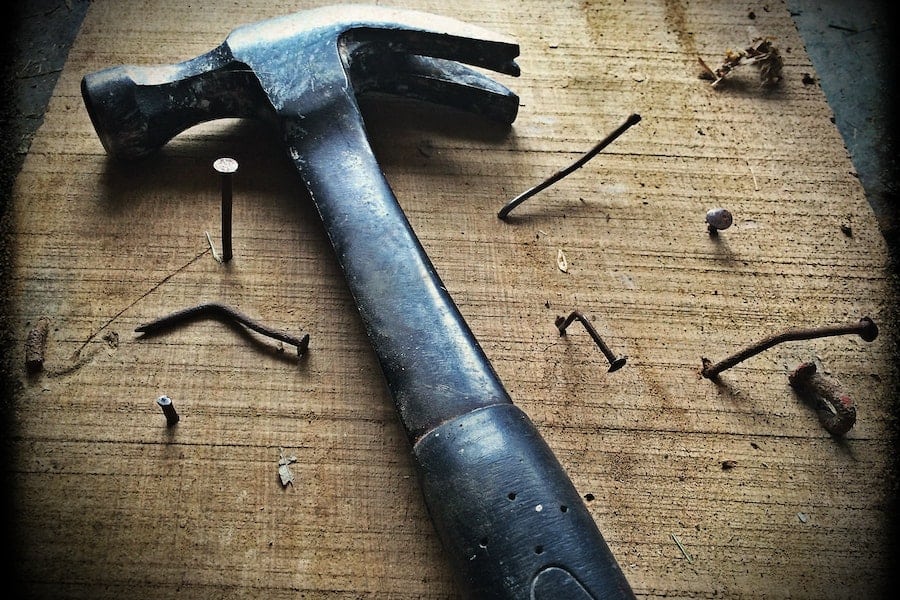Welcome to the fascinating world of the ball peen hammer! As one of the most versatile and enduring tools in history, this unassuming hammer has played an indispensable role in numerous trades and crafts for centuries. With its distinctive rounded peen opposite the flat striking surface, the ball peen hammer boasts a rich history of metalworking, blacksmithing, and automotive applications. But its uses don’t stop there – from jewelry making to woodworking, this tool has found its way into an array of specialized tasks. In this article, we’ll delve into the diverse applications and explore the timeless significance of the ball peen hammer, proving that even amidst modern technological advancements, some tools remain as indispensable as ever.
What Is A Ball Peen Hammer Used For?
A ball peen hammer is a versatile tool used primarily for metalworking and blacksmithing. It features a rounded end opposite the flat striking surface, known as the peen. This unique design allows for precise shaping and forming of metal sheets, wires, and panels. Additionally, it is employed in riveting, forging, and peening processes to manipulate and texture metals. Its applications include automotive repairs, dent removal, jewelry making, and even woodworking. With its enduring relevance and timeless significance, the ball peen hammer remains a valuable tool in various trades and crafts.
Understanding The Ball Peen Hammer
The ball peen hammer is a hand tool that has been used for centuries, valued for its versatility and effectiveness in various applications. It is characterized by its distinctive design, featuring a flat striking surface on one end and a rounded or ball-shaped peen on the other end. The peen can vary in size, with some hammers having a larger peen and others a smaller one.
The hammer’s head is typically made of metal, and the handle is commonly made of wood, though modern versions may use other materials like fiberglass or steel for added durability. The weight of ball peen hammers can also vary, with lighter options suitable for more delicate tasks and heavier ones for heavy-duty applications.
The flat end of the ball peen hammer is used for striking and hitting surfaces, much like a regular hammer. However, the actual value of the ball peen hammer lies in its peen, which opens up a wide range of uses that are not achievable with other hammers.
In metalworking, the rounded peen allows for precise shaping and forming of metal sheets, panels, and wires. The peen is particularly useful for riveting tasks, where it can be used to set and flatten the head of a rivet securely. Blacksmiths often use ball peen hammers for “peening” – a technique that involves striking the metal’s surface to spread and harden it, creating unique textures and patterns.
Beyond metalworking, the ball peen hammer finds applications in various specialized fields. In automotive repairs, it is used for dent removal and light metal fabrication tasks. Jewelry makers utilize the ball peen hammer to shape and texture metal components. It even has applications in woodworking for specific tasks, such as setting rivets in leatherwork.
Despite advancements in technology and power tools, the ball peen hammer remains an essential and irreplaceable tool for skilled artisans, craftsmen, and tradespeople. Its ability to shape, texture, and manipulate metal with precision ensures its enduring relevance in hand tools.
Traditional Uses Of A Ball Peen Hammer
The ball peen hammer has a long history and has been a vital tool in various traditional trades and crafts. Its unique design, with a flat striking surface on one end and a rounded peen on the other, enables a range of specialized applications. Here are some traditional uses of a ball peen hammer:
Metalworking: One of the primary uses of a ball peen hammer is in metalworking tasks. Metalworkers use the flat end for general striking and shaping metal, while the rounded peen is employed for more intricate work. It allows for precisely shaping metal sheets, panels, and wires, making it an indispensable tool in metal fabrication.
Blacksmithing: Blacksmiths utilize the ball peen hammer for various tasks. When working on the anvil, they use the peen to spread and shape the metal, a process known as “peening.” The peen is also helpful for texturing metal surfaces, creating unique patterns, and adding decorative elements to metal objects.
Riveting: Ball peen hammers are commonly used in riveting applications. The rounded peen is perfect for setting and flattening the head of rivets securely. This is crucial for joining pieces of metal together robustly and permanently.
Forging: In the process of forging metal, the ball peen hammer is employed to shape and manipulate hot metal on the anvil. Blacksmiths use it to draw metal into desired shapes and sizes, ensuring precise control over the forging process.
Sheet Metal Work: The ball peen hammer is ideal for forming and finishing metal objects in sheet metal work. Its rounded peen allows craftsmen to work on tight curves and angles, ensuring the metal conforms to the desired shape accurately.
Jewellery Making: Artisans and jewelers use the ball peen hammer to texture and shape metal components in jewelry making. The peen helps create intricate designs and textures on metals like silver and copper, enhancing the overall aesthetic appeal of the jewelry pieces.
Tips For Choosing The Right Ball Peen Hammer
Selecting the proper ball peen hammer ensures efficient and practical work. Here are some tips to help you choose the perfect ball peen hammer for your needs:
- Ball peen hammers come in various weights, ranging from lightweight to heavy-duty. Choose a hammer with a weight that matches the type of work you’ll be doing. For more delicate tasks, a lighter hammer offers better control, while heavier hammers are suitable for heavy-duty metalworking and blacksmithing.
- Traditional ball peen hammers have wooden handles, which offer a comfortable grip and dampen vibrations. However, modern options may feature fiberglass or steel handles, providing added durability and reduced risk of breakage. Select a handle material that suits your preferences and the durability required for your work environment.
- The length of the handle can impact the hammer’s balance and the force it generates. Longer handles provide greater leverage, making it easier to strike with force, but they might reduce precision. Shorter handles offer more control but may require more effort to deliver powerful strikes. Choose a handle length that suits the specific tasks you’ll be performing.
- The hammerhead should be made from high-quality metal to ensure durability and long-lasting performance. Look for hammers with hardened and tempered steel heads, as they are less prone to chipping and deforming.
- A smooth and polished hammerhead reduces the risk of damaging the workpiece’s surface during striking. Ensure the hammerhead has a smooth finish to minimize marring and dents on the metal.
Final Words
- In conclusion, the ball peen hammer is a timeless and indispensable tool, revered for its versatility and efficacy in various trades and crafts. From metalworking and blacksmithing to jewelry making and woodworking, its unique design, featuring a flat striking surface and a rounded peen, opens up a world of possibilities for artisans and craftsmen. When choosing the perfect ball peen hammer, consider weight, handle material, length, head material, finish, peen size, balance, and overall quality. Investing in a high-quality ball peen hammer ensures not only superior performance but also long-lasting durability and safety.
FAQ’s
What is a ball peen hammer used for?
A ball peen hammer is primarily used in metalworking and blacksmithing tasks. Its flat striking surface is used for general striking, while the rounded peen is employed for shaping, forming, and texturing metal surfaces. It is also used for riveting, forging, dent removal, jewelry making, and woodworking.
How do I choose the correct ball peen hammer?
To choose the correct ball peen hammer, consider weight, handle material, length, head material, finish, peen size, balance, and overall quality. Select a hammer that matches the work you’ll be doing and provides comfort and control during use.
What are the different sizes of ball peen hammers available?
Ball peen hammers come in various sizes, with different head weights and handle lengths. Smaller hammers are suitable for delicate tasks and intricate work, while larger hammers offer more power for heavy-duty applications.
















Leave a Reply